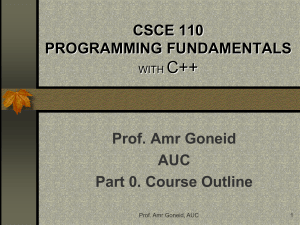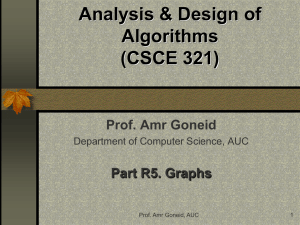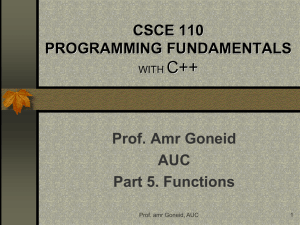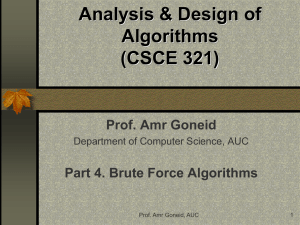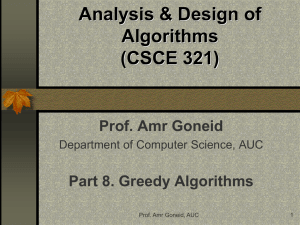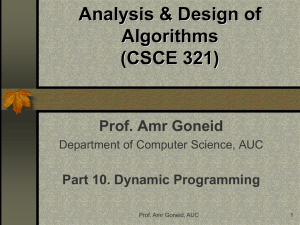Elementary Data Structures: Disjoint Sets
advertisement
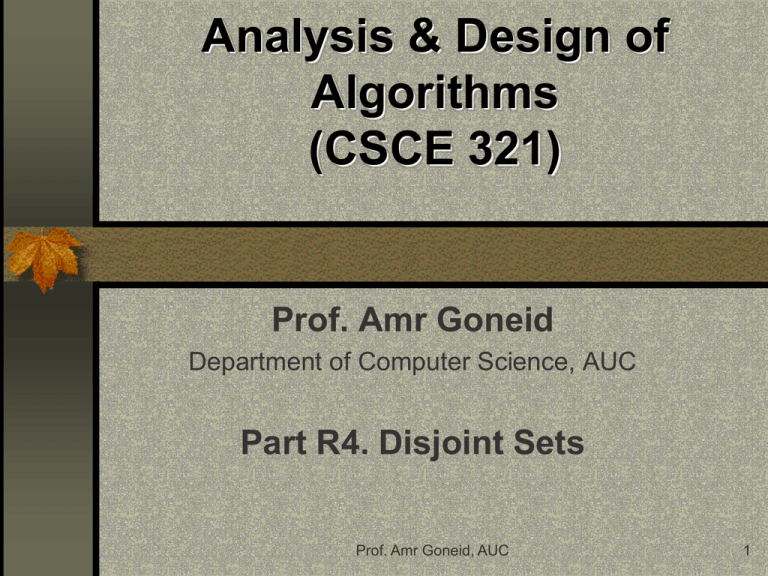
Analysis & Design of
Algorithms
(CSCE 321)
Prof. Amr Goneid
Department of Computer Science, AUC
Part R4. Disjoint Sets
Prof. Amr Goneid, AUC
1
Disjoint Sets
What
are Disjoint Sets?
Tree Representation
Basic Operations
Parent Array Representation
Simple Find and Simple Union
Disjoint Sets Class
Some Applications
Prof. Amr Goneid, AUC
2
What are Disjoint Sets?
A set S is a collection of elements of the same
type
We assume that the elements are the numbers
1,2,.. n. In practice, these numbers may be indices
to a symbol table containing the names of the
sets.
Disjoint sets are collections of elements with no
common elements between the sets. If Si and Sj,
i j are two sets, then Si Sj = Ø
Examples:
S1 = {1,7,8,9},
S2 = {5,2,10}, S3 = {3,4,6}
Prof. Amr Goneid, AUC
3
Union-Find Data Structure:Tree
Representation
One possible representation is a tree where a set can be
identified by a parent node and children nodes.
In this representation, children point to their parents, rather
than the reverse:
5
1
7
8
9
S1 = {1,7,8,9}
2
3
10
S2 = {5,2,10}
Prof. Amr Goneid, AUC
4
6
S3 = {3,4,6}
4
Basic Operations
Find(i):
Given the element (i), find the set containing (i),
i.e. find the root of the tree.
Union(i,j):
Given two disjoint sets Si and Sj, obtain a set
containing the elements in both sets, i.e.,
Si Sj
Prof. Amr Goneid, AUC
5
Parent Array Representation
n disjoint nodes can be represented as n disjoint sets where
each node is its own parent, i.e. p[i] = -1:
1
2
i
p[i]
1
-1
n
3
2
-1
3
-1
Prof. Amr Goneid, AUC
n
-1
6
Basic Operations
Find(i):
Finding out which subset we are in is simple, for
we keep traversing up the parent pointers until
we hit the root.
Prof. Amr Goneid, AUC
7
Simple Find
The value in p[i] represents the parent of node (i). For the sets
S1,S2,S3 shown before, we have:
i
1
2
3
4
5
6
7
8
9
10
p[i]
-1
5
-1
3
-1
3
1
1
1
5
Algorithm for Simple find:
Find the set containing node (i) = find the parent of (i):
int find(int i)
{
while (p[i] >= 0) i = p[i];
return i;
find (1) 1
find (4) 3
find (10) 5
}
Prof. Amr Goneid, AUC
8
Basic Operations
Union(i,j):
Making a union between two subsets is also easy.
Just make the root of one of two trees point to the
other, so now all elements have the same root
and thus the same subset name.
Prof. Amr Goneid, AUC
9
Simple Union
Simple (disjoint) Union:
Make set (i) the child of set (j) = union (i,j)
1
7
1
8
9
5
2
7
8
9
2
5
Example:
union(5,1)
10
10
Prof. Amr Goneid, AUC
10
Simple Union
The parent array would change to:
i
1
2
3
4
5
6
7
8
9
10
p[i]
-1
5
-1
3
1
3
1
1
1
5
Algorithm:
void union (int i, int j)
{ p [i] = j ; }
Prof. Amr Goneid, AUC
11
Disjoint sets class
class Sets
{
private:
int *p, n;
public:
Sets(int Size): n(Size)
// Constructor
{
p = new int[n+1];
for (int i=0; i<=n; i++) p[i] = -1;
}
Prof. Amr Goneid, AUC
12
Disjoint sets class
~Sets()
// Destructor
{ delete [ ] p; }
void SimpleUnion(int i, int j);
int SimpleFind(int i);
};
Prof. Amr Goneid, AUC
13
Disjoint sets class
// Make set(i) the child of set(j)
void Sets::SimpleUnion(int i, int j)
{ p[i] = j;
}
// Find the parent set of subset(i)
int Sets::SimpleFind(int i)
{ while (p[i]>=0) i = p[i];
return i;
}
Prof. Amr Goneid, AUC
14
Analysis
Union: takes constant time, i.e., O(1)
Find: Suppose we do the following sequence of
unions:
union(1,2) , union(2,3),...., union(n-1,n)
The time of find parent of node (i) will be i.
To process all finds, we need
(1+2+....+n) steps = O(n2)
Hence, the average find cost is O(n)
n
n-1
2
1
Prof. Amr Goneid, AUC
15
Improvement
We can improve the find cost by modifying the union
algorithm to be:
“make the root of the smaller tree point to the root of
the bigger tree”
In this case, the cost of find is O(log n)
Implementation:
Store the node count in each root. Modify the count
when making a union.
Prof. Amr Goneid, AUC
16
Modified Disjoint sets class
class Sets
{
private:
int *p, *c, n;
public:
Sets(int Size): n(Size)
// Constructor
{
p = new int[n+1]; c = new int[n+1];
for (int i=0; i<=n; i++) {p[i] = -1; c[i] = 1}
}
Prof. Amr Goneid, AUC
17
Disjoint sets class
~Sets()
// Destructor
{ delete [ ] p; delete [ ] c;}
void SimpleUnion(int i, int j);
int SimpleFind(int i);
};
Prof. Amr Goneid, AUC
18
Disjoint sets class
// Make a union between set(i) and set(j)
void Sets::SimpleUnion(int i, int j)
{
int sum = c[i] + c[j];
if (c[i] > c[j]) {p[j] = i; c[i] = sum;
else { p[i] = j; c[j] = sum;}
}
}
// Find the parent set of subset(i)
int Sets::SimpleFind(int i)
{
while (p[i]>=0) i = p[i];
return i;
}
Prof. Amr Goneid, AUC
19
Some Applications
Representation
of disjoint collections of
data
Representation of Trees, Forests and
Graphs
Prof. Amr Goneid, AUC
20
Sets Class
The CSCI 321 course web site contains full
definitions and implementations of :
Sets class: Disjoint sets class with dynamic
array representation
Prof. Amr Goneid, AUC
21
Learn on your own about:
The C++ STL set container
Prof. Amr Goneid, AUC
22

